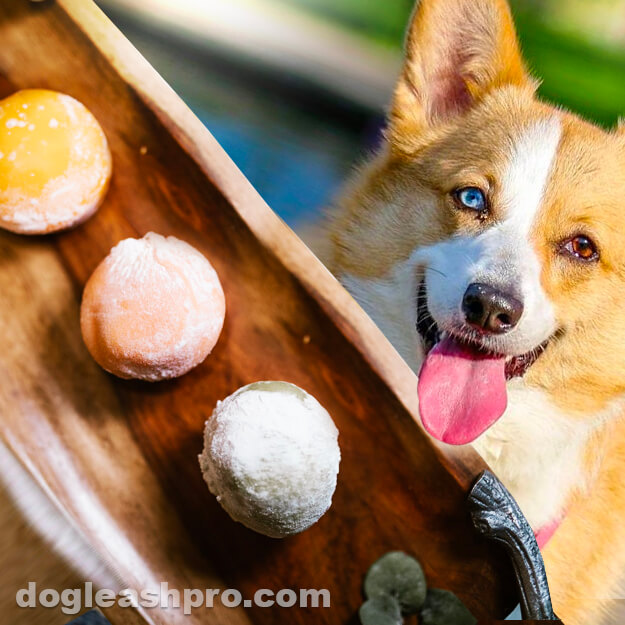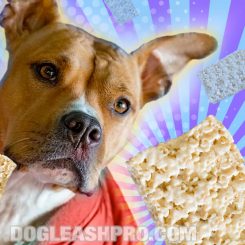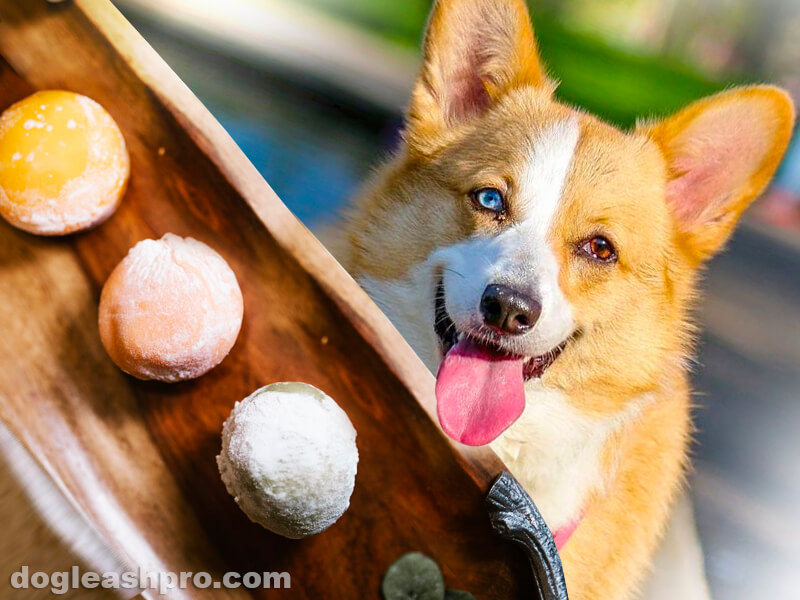
Who doesn’t love a cool, chewy, and sweet dessert year-round? At least once a week, I’ll have Mochi with a cup of red tea. My Chihuahua loves food and would try to get my attention by pawing at me. Today, she gave me her puppy eyes. I was about to give her a small taste but wondered if Mochi is safe for dogs to eat.
Can dogs eat Mochi? No, dogs should not eat Mochi because it has a high sugar content and dogs generally are not able to digest glutinous rice flour properly. Eating Mochi can put stress on their organs, cause gas and bloating, and lead to both breathing problems and pancreatic inflammation. Many dogs do not chew before they swallow so Mochi could be a potential choking hazard. For these reasons, it’s best to avoid feeding your dog this sweet rice cake dessert.
Table of Contents
Is Mochi bad for dogs?
To fully understand whether Mochi is safe or bad for dogs, we need to be aware of the ingredients that go into making this sweet dessert. Let’s dive in and see what they are.
What is Mochi? (History of Mochi)
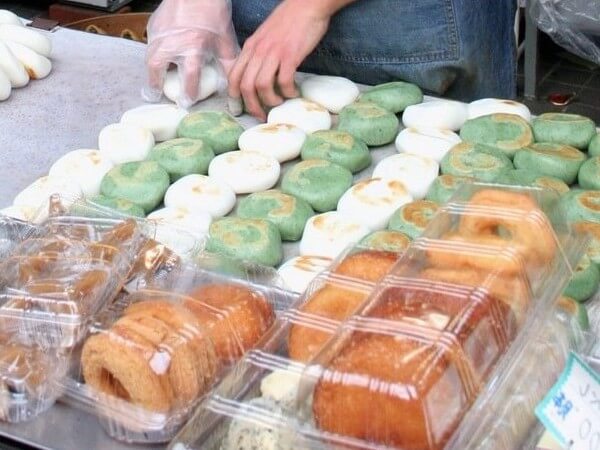
Mochi is a chewy, sweet, stretchy, and sticky Japanese rice cake dessert that was first introduced in Japan in as early as 300 BC. It is shaped like a small round ball and is bite-sized. It’s a tradition for many Japanese to make and eat mochi.
Although Mochi is now eaten throughout the year by many people of different backgrounds around the world, it used to be a sacred food that holds great significance during the Japanese New Year. The Japanese in ancient times would eat this and pray for prosperity and good health.
What is Mochi made of?
Generally, the sweet chewy rice cake ball is made from short-grain glutinous rice because this type of rice gives the Mochi its chewy texture. This glutinous rice is called mochigome or mochi rice, which is where the name Mochi came from.
Traditionally, you would soak this glutinous short-grain rice overnight in water or for about 10 to 12 hours. Soaking glutinous rice in water overnight helps to give the sticky rice a tender and even texture and gives it more flavor.
After, you steam it until it has this elastic and smooth texture. You’ll notice that it is sticky, stretchy, and soft. Then you use a heavy mallet and a mortar to press and pound the rice while adding water into it to get it to the right texture and consistency.
Using modern technology and equipment today, Mochi is made from sweet Japanese glutinous rice flours, water, sugar, and cornstarch. Depending on the flavors and texture, additional ingredients are added accordingly.
Today, there are different types of Mochi that come in several different flavors and styles. In this article, we will touch on both Mochi balls and Mochi ice cream.
Fun Fact: Tapioca pearls or Boba also has a smooth chewy texture and can also be a choking hazard for dogs.
What is a Mochi ball?
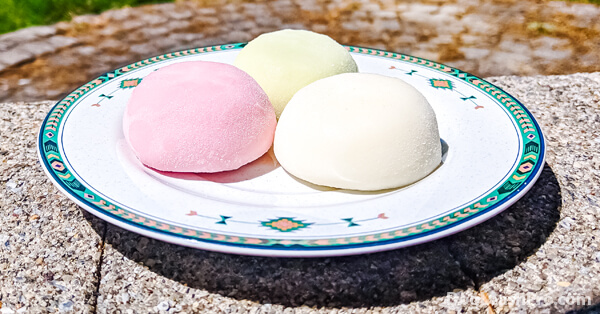
Mochi ball is a rice ball with a tasty sweet interior filling. The internal filling can be filled with one of these different flavors which includes:
- White bean paste.
- Red bean paste.
- Green bean paste.
- Custard.
- Strawberries.
- Ice cream (also known as Mochi ice cream).
With that said, let’s go over the ingredients in a matcha flavor Mochi ball with red bean paste filling:
Ingredients in Mochi ball
Sweetened red bean paste (Harmful)
Plain-cooked red beans are healthy for dogs. They are packed with fiber to help the dog’s digestive system. However, sweetened red bean paste is harmful to our canine companions.
Sweetened red bean paste is made of red bean, sugar, and salt. The red bean is mixed with either white sugar or dark brown sugar or both. This added sugar makes the red bean paste very sweet.
Dogs that eat snacks with too much sugar can start to gain weight, have diabetes, dental issues, and pancreatitis.
In addition, the red bean paste may have added butter for that creamy texture and flavor.
The ingredients used in sweetened red bean paste are what makes it dangerous for our pooch.
Sweet rice flour (Safe in moderation but can be a choking hazard)
Sweet rice flour comes from sticky rice or short-grain glutinous rice, which has a higher starch content compared to other types of rice. Using this type of rice is great for binding ingredients and is perfect for making Mochi.
While this type of rice is called “glutinous” rice, it is actually gluten-free. Additionally, this rice flour is not sweet even though it is called sweet rice flour. It is actually kind of milky and mild in flavor.
Sweet rice flour is neither the best type of flour for dogs nor is it toxic, so having a little bit of sweet rice flour won’t hurt your dog if it is in small and moderate amounts. The best type of flour for dogs are:
- Coconut flour
- Brown rice flour.
- Almond flour.
- Oat flour.
- Quinoa flour.
- Buckwheat flour.
The sweet rice flour is generally safe for dogs that are sensitive or allergic to wheat grain flour.
However, there are two reasons why sweet rice flour may not be safe for your furry friends.
- If your pooch is allergic to grain-based starches or flour.
- The sweet rice flour makes the Mochi ball very sticky. Mochi ball is a hand-to-mouth sweet snack. From my experience, the exterior layer of the Mochi ball (made of sweet rice flour) would stick to my fingers as I’m trying to finish up my last bite. This is a bit annoying and knowing how sticky it is, I do not feel comfortable giving Mochi balls to my pooch even though she is giving me the puppy eyes.
The sweet rice flour is used as the exterior layer of the Mochi ball and again for dusting once the Mochi ball is done.
If you must feed your pooch Mochi ball, make sure to give them just a small tiny piece. To avoid choking on this chewy and sweet rice ball, avoid giving them the whole Mochi ball. Dogs generally do not have a habit of chewing their food before they swallow so Mochi balls can be a choking hazard.
Before you feed the Mochi ball to your furry friends, make sure to cut it up into very small pieces first before feeding them to your pooch.
Fun Fact: If you choose to feed your pooch Reese’s Pieces (not recommended for regular consumption), we highly advise that you cut it up into smaller pieces. This will help to avoid any choking or getting stuck in the small intestine.
Green tea powder (Harmful)
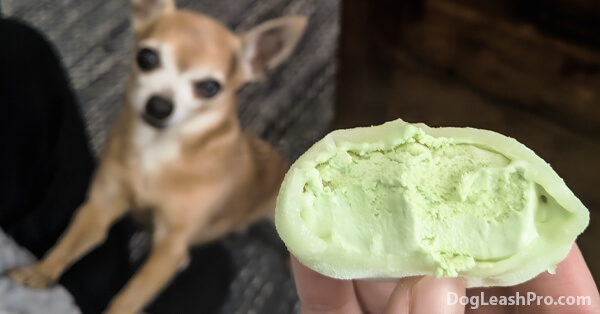
Since the Mochi ball will be matcha-flavored for its rice covering, you would use green tea powder. However, it’s important to note that not all green tea powder is matcha.
Green tea powder has a soft olive green color. The green tea powder comes from green tea which contains caffeine. In fact, green tea powder contains more caffeine than green tea bags or loose leaves.
This is what makes green tea powder very dangerous to our canine friends. If you’re using green tea powder to add flavor to your Mochi rice balls, avoid feeding them to your pup.
Consuming food with caffeine can cause caffeine toxicity in as short as 30 minutes. Some symptoms of caffeine toxicity include:
- Hyperactivity.
- Restlessness.
- Panting.
- Vomiting.
- Agitation.
- Seizures.
- Tremors.
If green tea powder is in the ingredients, we advise that you keep the Mochi ball away from your pooch.
Sugar (Harmful)
Sugar is purposely added to give sweetness to the Mochi ball. It is added to the sweet rice flour and water during the mixing process. As mentioned above, contrary to the name sweet rice flour, this flour is not sweet at all. It is actually mild and a bit milky in flavor.
Without the added sugar, the Mochi balls would not have a sweet exterior. For this reason, Mochi ball is dangerous to dogs due to its sugar content.
Ingesting too much sugar can cause the following in dogs:
- Diarrhea.
- Vomiting.
- Weight gain.
- Dental issues such as tooth decay and cavities.
- Diabetes.
- Decrease muscle tone.
- Low energy level.
- Immunity is compromised.
- Digestion issues.
- Inflammation throughout the body leading to pancreatitis, dermatitis, and arthritis.
Cornstarch (Safe)
Cornstarch is used to prevent one Mochi ball from sticking to another Mochi ball. It has a naturally sweet flavor. Cornstarch is used in some dog food and it’s great for dogs that are allergic to corn and cornflour.
Now that you’re aware of the ingredients that are used to make Mochi balls, let’s read on to learn about Mochi ice cream. Mochi ice cream is the second most popular form of Mochi.
What is Mochi ice cream?
Mochi ice cream is exactly Mochi balls, but the only difference is that it has an ice cream filling. The ice cream filling can be any flavor. You’ll find them in strawberry, vanilla, and green tea flavors.
Let’s discuss the ingredients in the Mochi ice cream and see whether it is safe for doggy consumption.
Here, we’ll use the Trader Joe’s Green Tea Mochi ice cream as an example.
Ingredients in Trader Joe’s Green Tea Mochi Ice Cream
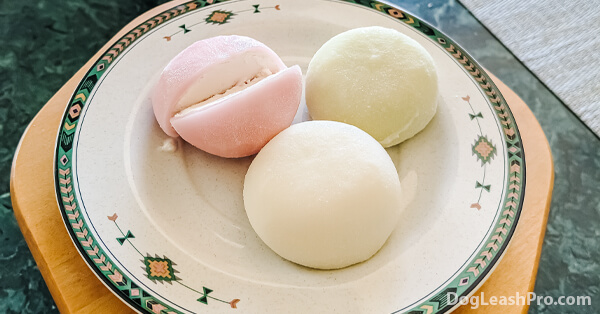
Mochi ice cream is a great cold and chewy dessert during the summer. Every summer, I have Mochi ice cream at least once a week.
Here are the ingredients in the Trader Joe’s Green Tea Mochi ice cream:
- Green tea ice cream (Nonfat milk, cream, cane sugar, green tea leaf powder, carob bean gum, and guar gum).
- Rice dough (Cane sugar, sweet rice flour, water, and tapioca syrup*).
- Egg whites.
- Color Added (Turmeric extract, spirulina).
*Tapioca syrup contains Tapioca, water, sea salt, and vanilla bean seeds.
At first glance over these ingredients, you may already be shaking your head. I know I was because some of the ingredients are definitely dangerous for dogs. Let’s go over these ingredients:
Green tea ice cream (Harmful)
Nonfat milk and cream
If your pooch is lactose-intolerant, it’s best for him or her to stay away from dairy products. Eating food that has nonfat milk and cream such as Mochi ice cream can cause symptoms like diarrhea, vomiting, bloating, gas, abdominal pain, and loose stools.
Cane sugar
It’s best to avoid giving your furry family member sugary snacks or treats because they are not good for dogs. Added sugar such as cane sugar can be harmful to our canine friends. Regularly feeding your canine friends sugar can lead to weight gain, obesity, diabetes, and pancreatitis.
Green tea leaf powder
As mentioned above, green tea leaf powder contains more caffeine than regular green tea bags or loose leaves. Due to this, we would recommend that you avoid giving your pooch treats that contain green tea leaf powder. Within 30 minutes of consuming caffeine, your pooch may experience caffeine toxicity. See above for potential symptoms of caffeine toxicity.
Carob bean gum and guar gum
Both carob bean gum and guar gum are safe for dogs. Carob bean gum is healthy and natural and will provide health benefits to dogs. Guar gum is found in many dog foods, is used as a binder in pet food so the food stays together, and is FDA approved. Since these two ingredients are mixed with other harmful ingredients, they are no longer safe for dogs to ingest.
Rice dough (Harmful)
Cane sugar
We recommend that you avoid feeding your pooch treats and snacks that contain cane sugar or any added sugar. Regularly feeding your furry friends sugar is harmful to their health because it can affect their mood and energy level and can eventually lead to canine obesity, diabetes, and pancreatitis.
Sweet rice flour
Sweet rice flour is potentially harmful to dogs. When used to make the exterior surrounding of the Mochi, it is very sticky and this can be a choking hazard for dogs. Since Mochi ice cream is a hand-held dessert, you can see how the exterior sticks to your fingers as you’re trying to finish the last bite. See above for more information on sweet rice flour.
Tapioca syrup
While tapioca is safe for dogs, tapioca syrup is not. Tapioca syrup is sometimes used to replace corn syrup so it is a sweetener. Again, tapioca syrup is sugar and sugar does not benefit our canine companions in any way.
Egg whites (Safe when fully cooked)
Cooked egg whites are safe for doggy consumption. Research shows that eating raw egg whites can cause biotin deficiency in dogs.
Eggs in general are safe for canine consumption. They provide nutrients such as protein, vitamins, minerals, iron, potassium, zinc, phosphorus, and magnesium for dogs.
However, when mixed with other harmful ingredients in the Trader Joe’s Green Tea Mochi ice cream, it is no longer beneficial. In the case of Mochi ice cream, it’s best to avoid feeding this to your pooch.
Color Added [Turmeric extract, Spirulina] (Safe in small quantities)
Both turmeric extract and Spirulina are safe for dogs if consumed in small quantities. Spirulina is a superfood. When you add Spirulina to your pup’s daily diet, it can help boost their health and well-being. Spirulina is especially helpful for senior dogs.
Dog-friendly and safe alternatives to Mochi
Based on the information above, we highly recommend that you avoid feeding Mochi to your pooch, whether it is in the form of Mochi ball or Mochi ice cream. Since they are made of sweet rice flour and sweet rice dough, the exterior surrounding tends to be very sticky, which can be a choking hazard for dogs.
Additionally, Mochi is very sweet. This dessert is intended for human consumption. Allowing your canine family member to consume too much sugar can lead to many health issues and an expensive vet bill later on.
Although I feel bad for not sharing my Mochi balls or Mochi ice cream with my Chihuahua, I make it up with this canine-friendly ice cream treat:
So, can dogs eat Mochi?
It’s best to keep Mochi away from your canine companions. While dogs will eat anything we are eating, it doesn’t mean that they should. As responsible dog owners, we want to make sure our pooch lives a long healthy life. With that said, let’s avoid feeding them Mochi and give them healthy food and treats instead.
DISCLAIMER: THIS WEBSITE DOES NOT PROVIDE MEDICAL ADVICE
The information, including but not limited to, text, graphics, images and other material contained on this website are for informational purposes only. No material on this site is intended to be a substitute for professional veterinary advice, diagnosis, or treatment. Always seek the advice of your veterinarian or other qualified health care provider with any questions you may have regarding dietary needs.
Resources:
https://en.wikipedia.org/wiki/Mochi
https://www.bbc.com/news/world-asia-42537953

With over five years of specialized experience as an animal writer, my expertise lies in dog nutrition, health, behavior, grooming, and training. I am dedicated to delivering helpful and informative content that caters to the well-being of our furry friends. My primary goal is to empower pet owners with knowledge and ensure our canine companions thrive in health and happiness. In my free time, I love volunteering at local dog rescue centers.
